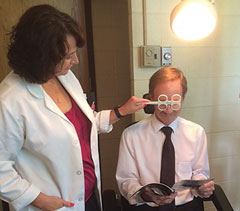 |
| Teaching patients over 40 about new contact lens options may help them branch out to find one better suited for them. Photo: Julie DeKinder, OD. Click image to enlarge. |
The market is saturated with contact lens options, but people older than 40 especially tend to be more unwilling to try them. A recent study attempted to identify how to increase contact lens usage among these patients.
Data from 1,540 participants 40 years and older with presbyopia who were existing contact lens wearers or willing to try contact lenses were included.
Overall, 50.8% of the participants wore contact lenses, but lens wear was less common among older participants. Some of the usage data supported findings of earlier studies; notably, just 25% used multifocal contact lenses.
The reasons the participants wanted to try contact lenses were similar to those of younger patients, such as sports and cosmesis factors. There was a drop-off in contact lens use in patients over 50 due to poor visual performance and an increased likelihood of age-related dry eye and other ocular issues.
A large number of the participants were already using multifocal spectacles, which the study authors said shows a good awareness of this product range. “There may be an opportunity to dispense multifocal spectacles to the others offering them dual wear, where they utilize both spectacles and contact lenses as required and are not solely using one or the other,” the researchers noted in their paper.
The investigators also suggested the biggest opportunity seems to be with multifocal contact lenses, since only a quarter of the participants were currently wearing them, especially considering those who already wore multifocal spectacle lenses.
Lastly, the study highlights some failings by eyecare practitioners in the management of patients with presbyopia. “It seems that patients of this age group are seeking suggestions and recommendations from their eyecare practitioner including upgrading contact lenses and dual wear options,” the authors suggested. “The day-to-day problems encountered by the contact lens wearers in this study seem to be, in the main, things that could be easily tackled by additional counseling and instruction from eyecare practitioners.”
Naroo SA, Nagra M, Retallic N. Exploring contact lens opportunities for patients above the age of 40 years. Cont Lens Anterior Eye. April 12, 2022. [Epub ahead of print]. |

